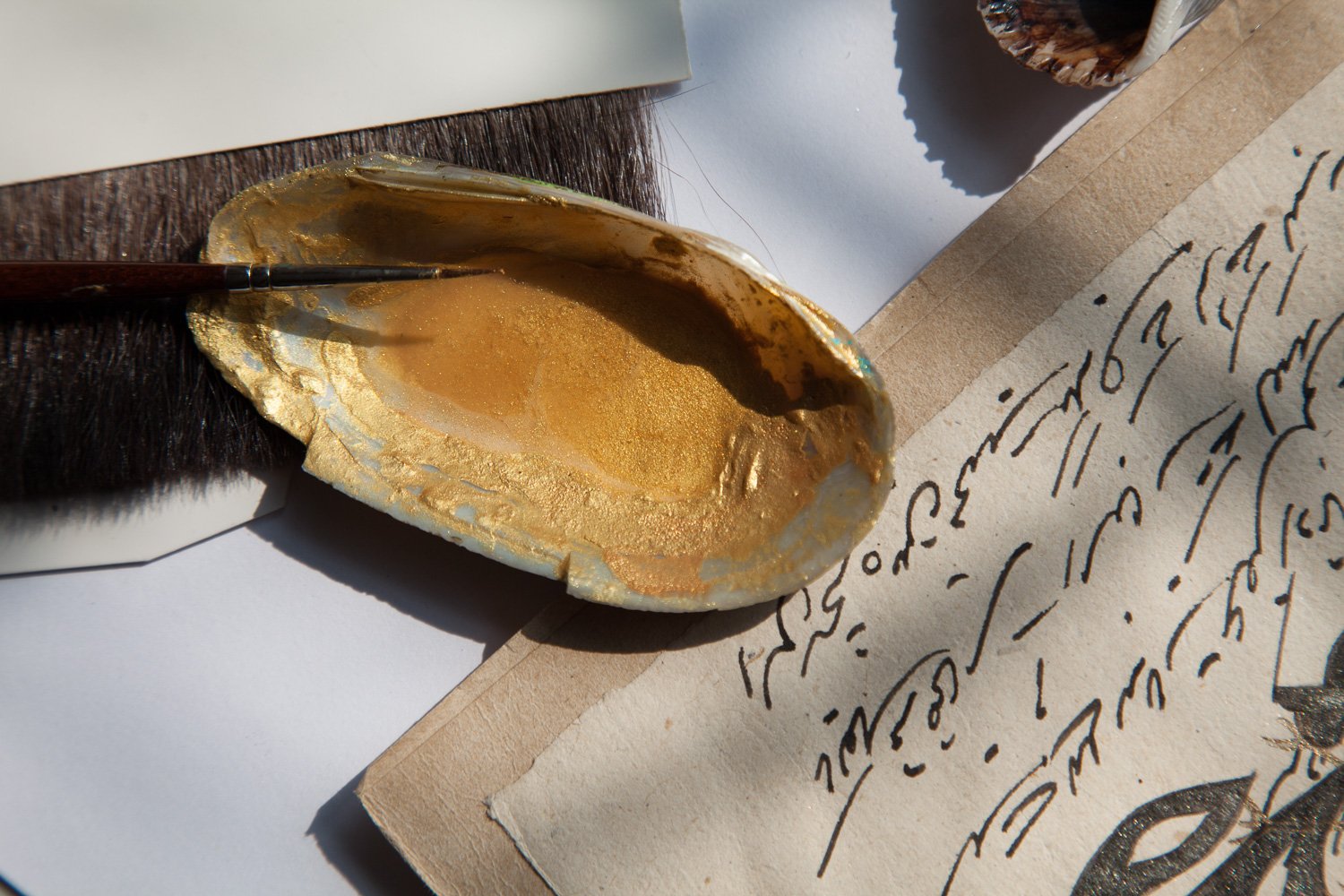
In the energy, the design flow balances, growing, naturally sprouting, sometimes in the night sky, in dark voids and hidden places, textures and tessellation’s riding over the original geometric grid and allowing the artist’s hand mastery of expression.
THE PROCESS
The rich technical issues of Mughal painting make it a focused skill which initially relies on layered washes of diluted paint. This slow methodical build up of painted layers onto a base of hand made Wasli paper, are both formative and tenuous until finally burnished into a transformative deep glow.
Growing a rich depth of colour, is the result of pressing and bonding of natural pigments combining to create the gem-like qualities attributed to this ancient art.
This richness through fusion is additionally created by combining and choosing colours rich in symbolism and is historically developed over millennia.
Each colour is separately ground, washed, filtered and powdered over a period of time. Every different pigment is bound together and tested with very specific amounts of gum arabic and other binders; depending entirely on the mineral being prepared.
Natural plant dyes are also mixed and blended differently and bindings can include naturally antiseptic Melipona honey and gelatin.
It is a painstaking and contemplative process requiring much care and energy!
Only then are details and designs finally laid down and a certainty of placement is fixed. An extraordinary amount of time is spent, so a clearly planned design needs to be thoughtfully prepared for layout.
This is the time an active momentum and magic begins taking shape; the curved and pointed tip of the handmade squirrel tail brush licks fine lines and detailing, enhanced highlights and exaggerated swishes in the dramatic and lively handling by the artist begin to manifest.
Practicing is required to develop a good hand, as deft strokes in ink and washes in a light motion need to fully inhabit the page, and in this the detailing, the bounce and flow of the brush and ink, the tiny light and delicate marks are everything, the hand and the life energy of the artist flows here.
In the composition and layout, geometric designs and patterns are often the origin of motifs used, compass and rule accurately settle and identify a distinct design
To begin a study is to learn that there are very particular ways to render and draw out designs, and much practice and patience is required.
Every geometric symbol is also a symbol of a more cosmic law, a primordial symbol passed down through eons of time instructing and invoking powerful forces.
There is symbolism in numbers, in the divisions of numbers, and their repetitions, even in the number of blossoms on a tree, of the petals in a blossom; of the placement, and their concentration, the spiralling and axis; each exercise designed awakens a certain spiritual force.
Sacred mythological traditions are passed down and re-interpreted also in other religions, in time as cultures and geographic boundaries move the images sometimes unfortunately lose their powers or essence, it is invaluable to study and understand at source in traditional ateliers.
All of the symbols represent a microcosm of the seen and unseen universe we inhabit, the universal laws we subtly live by.
Choices of colours, metals and even gemstones play key elements in the portrayal of these traditional symbols.
The biomorphic swirling design, and the unfolding pattern is a particularly distinct aspect of Islamic art.
An art that travelled from Persian courts to Mughal India, diversifying through time into Gothic, Neo Mughal, Indo Gothic and Company art, and with links to China too.
In its ancient origin, it is symbolic of an underlying unity and force of nature, at once flowing decoratively and seemingly naturally; yet based on distinctive geometric layouts.
These similarly distinct circular patterns, represent a unity and connection in nature that also underlies most ancient patterns from Celtic, Islamic and early aboriginal tribal art, a recognition of the powerful forces of nature.







